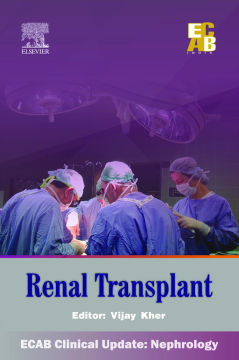
Additional Information
Book Details
Abstract
Kidney transplantation is one of the breakthroughs in medical science. The most important consideration in the procedure is the natural tendency of the human immune system to reject any foreign tissue—be it a harmful bacteria or a life-saving kidney. After transplantation, the immune system of the patient will reject the kidney in no time. The answer to the solution has been the tremendous development in the identification and use of immunosuppressive medicines. But on the other hand, as we reduce the strength of immune system, the patients are highly prone to infections and it can cause life-threatening infections if left undiagnosed. So, the greatest job of the nephrologist is to balance the immune system to a level where the kidneys are not rejected and at the same time keep the immune system at a level where the infections are kept under control. This is akin to walking on a tight rope.
The last few years witnessed significant improvisations in kidney transplantation—the introduction of newer immunosuppressive drugs to increase the success rates of transplantation; steps to increase the donor availability (by doing ABO incompatible transplantation and by performing transplants from non-heart beating donors); and lastly, kidney removal from the donor through laparoscopic donor nephrectomy.
This book focuses on the various aspects of choosing the donor, to donor nephrectomy, the outpatient care of the donor and the recipient and also the legal and ethical issues related to the same.
Table of Contents
| Section Title | Page | Action | Price |
|---|---|---|---|
| Front Cover | Front Cover | ||
| Front Matter | ia | ||
| Copyright | id | ||
| ECAB Clinical Update:Nephrology | ie | ||
| Renal Transplant | if | ||
| About the Authors | ig | ||
| Contents | ik | ||
| ECAB Clincal Update Infromation Renal Transplant | i | ||
| Preface | v | ||
| Selection and Preparationof the Recipient | 1a | ||
| ABSTRACT | 1a | ||
| KEYWORDS | 1a | ||
| INTRODUCTION | 1 | ||
| HISTORY | 2 | ||
| PHYSICAL EXAMINATION | 3 | ||
| Elderly Recipients | 3 | ||
| Pediatric Recipients | 3 | ||
| Obesity | 4 | ||
| PSYCHOLOGICAL EVALUATION | 4 | ||
| PRE-TRANSPLANT INVESTIGATIONS | 5 | ||
| EVALUATION OF INFECTIONS | 5 | ||
| EVALUATION OF CANCER | 8 | ||
| ORIGINAL RENAL OR SYSTEMIC DISEASE | 9 | ||
| Primary Glomerulonephritis | 9 | ||
| EVALUATION OF SPECIFIC SYSTEMS | 10 | ||
| Urological Investigations | 10 | ||
| Gastrointestinal Evaluation | 12 | ||
| Cardiovascular Evaluation | 12 | ||
| Pulmonary Evaluation | 14 | ||
| ROLE OF PRETRANSPLANT NATIVENEPHRECTOMY | 14 | ||
| LEGAL ISSUES IN TRANSPLANT | 14 | ||
| CONCLUSIONS | 14 | ||
| Selection of Donor | 23a | ||
| Donor Nephrectomy | 43a | ||
| ImmunosuppressiveAgents in KidneyTransplant Recipients | 83a | ||
| ABSTRACT: | 83a | ||
| Monitoring of theTransplant Recipientand Complications | 131a | ||
| Other Books in This Series | 154 |
